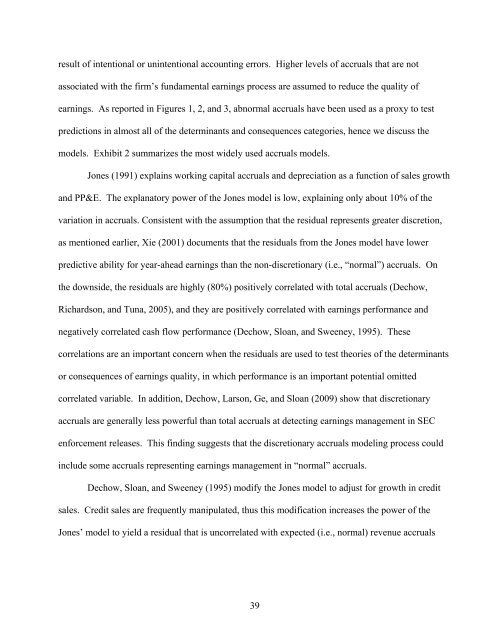Understanding earnings quality - MIT Sloan School of Management
Understanding earnings quality - MIT Sloan School of Management
Understanding earnings quality - MIT Sloan School of Management
You also want an ePaper? Increase the reach of your titles
YUMPU automatically turns print PDFs into web optimized ePapers that Google loves.
esult <strong>of</strong> intentional or unintentional accounting errors. Higher levels <strong>of</strong> accruals that are not<br />
associated with the firm’s fundamental <strong>earnings</strong> process are assumed to reduce the <strong>quality</strong> <strong>of</strong><br />
<strong>earnings</strong>. As reported in Figures 1, 2, and 3, abnormal accruals have been used as a proxy to test<br />
predictions in almost all <strong>of</strong> the determinants and consequences categories, hence we discuss the<br />
models. Exhibit 2 summarizes the most widely used accruals models.<br />
Jones (1991) explains working capital accruals and depreciation as a function <strong>of</strong> sales growth<br />
and PP&E. The explanatory power <strong>of</strong> the Jones model is low, explaining only about 10% <strong>of</strong> the<br />
variation in accruals. Consistent with the assumption that the residual represents greater discretion,<br />
as mentioned earlier, Xie (2001) documents that the residuals from the Jones model have lower<br />
predictive ability for year-ahead <strong>earnings</strong> than the non-discretionary (i.e., “normal”) accruals. On<br />
the downside, the residuals are highly (80%) positively correlated with total accruals (Dechow,<br />
Richardson, and Tuna, 2005), and they are positively correlated with <strong>earnings</strong> performance and<br />
negatively correlated cash flow performance (Dechow, <strong>Sloan</strong>, and Sweeney, 1995). These<br />
correlations are an important concern when the residuals are used to test theories <strong>of</strong> the determinants<br />
or consequences <strong>of</strong> <strong>earnings</strong> <strong>quality</strong>, in which performance is an important potential omitted<br />
correlated variable. In addition, Dechow, Larson, Ge, and <strong>Sloan</strong> (2009) show that discretionary<br />
accruals are generally less powerful than total accruals at detecting <strong>earnings</strong> management in SEC<br />
enforcement releases. This finding suggests that the discretionary accruals modeling process could<br />
include some accruals representing <strong>earnings</strong> management in “normal” accruals.<br />
Dechow, <strong>Sloan</strong>, and Sweeney (1995) modify the Jones model to adjust for growth in credit<br />
sales. Credit sales are frequently manipulated, thus this modification increases the power <strong>of</strong> the<br />
Jones’ model to yield a residual that is uncorrelated with expected (i.e., normal) revenue accruals<br />
39
















